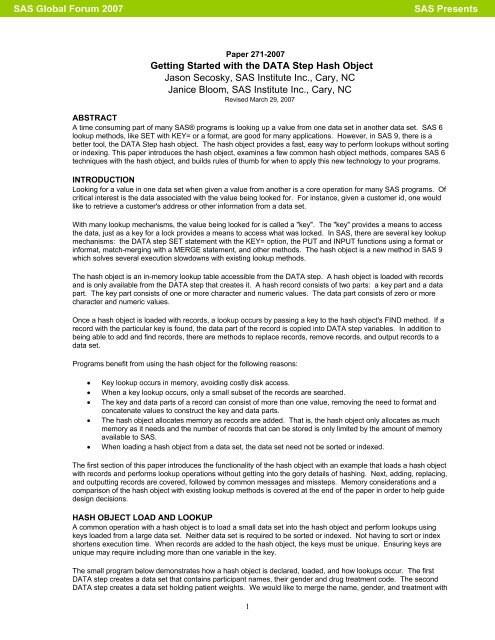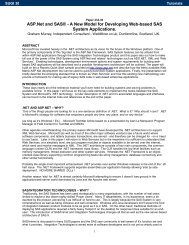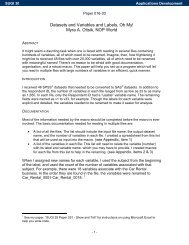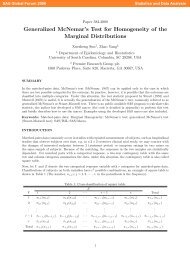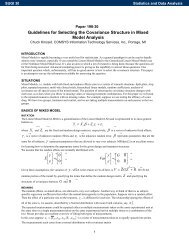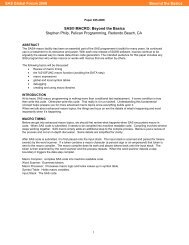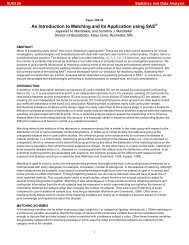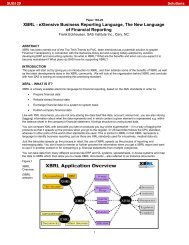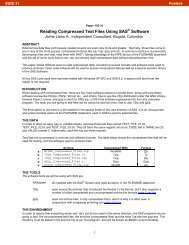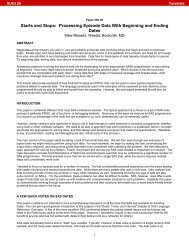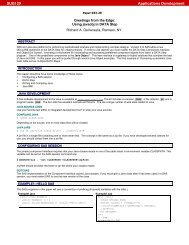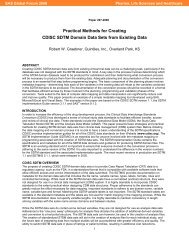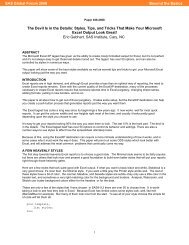271-2007: Getting Started with the DATA Step Hash Object - SAS
271-2007: Getting Started with the DATA Step Hash Object - SAS
271-2007: Getting Started with the DATA Step Hash Object - SAS
You also want an ePaper? Increase the reach of your titles
YUMPU automatically turns print PDFs into web optimized ePapers that Google loves.
<strong>SAS</strong> Global Forum <strong>2007</strong><strong>SAS</strong> PresentsSantos 2nd 00:42Santos 2nd 03:46Jones 2nd 11:15;data _null_;length goals_list $ 64;if _N_ = 1 <strong>the</strong>n do;declare hash h();h.defineKey('player');h.defineData('player', 'goals_list');h.defineDone();end;set goals end=done;if h.find() ^= 0 <strong>the</strong>n do;goals_list = when;h.add();end;else do;goals_list = trim(goals_list) || ', ' || when;h.replace();end;if done <strong>the</strong>nh.output(dataset:'goal_summary');run;proc print data=goal_summary;run;Output:Obs player goals_list1 Hill 1st 01:242 Santos 1st 12:45, 2nd 00:42, 2nd 03:463 Jones 1st 09:43, 2nd 11:15When <strong>the</strong> hash object is created, <strong>the</strong> key variable is PLAYER and <strong>the</strong> data variables are PLAYER and GOALS_LIST.The reason PLAYER is part of <strong>the</strong> data is discussed later. GOALS_LIST stores <strong>the</strong> list of <strong>the</strong> times each goal wasscored and is <strong>the</strong> data to be updated when REPLACE is called.For each observation read from GOALS, <strong>the</strong> FIND method determines if a record exists in <strong>the</strong> hash object for <strong>the</strong>player. If a record does not exist, we need to initialize <strong>the</strong> value of GOALS_LIST to <strong>the</strong> time of <strong>the</strong>ir first goal and callADD to add <strong>the</strong> player to <strong>the</strong> hash object. If a record exists, FIND would have filled GOALS_LIST <strong>with</strong> a list of all <strong>the</strong>goals scored. We need to concatenate <strong>the</strong> latest goal scored to GOALS_LIST. The concatenation is performed andREPLACE is called to replace <strong>the</strong> player's old list <strong>with</strong> <strong>the</strong> new list we created in GOALS_LIST.Once <strong>the</strong> input data set has been exhausted, <strong>the</strong> OUTPUT method writes <strong>the</strong> data portion of every record in <strong>the</strong> hashobject to <strong>the</strong> data set listed after <strong>the</strong> <strong>DATA</strong>SET: argument tag. In this case, <strong>the</strong> data set GOAL_SUMMARY containsobservations that contain <strong>the</strong> player's name and <strong>the</strong>ir summary of goals. OUTPUT only outputs data variables. Thisis <strong>the</strong> reason PLAYER was defined as a data variable, so that it would appear in <strong>the</strong> final output.OUTPUT can create a data set sorted by <strong>the</strong> key variables. Sorted output is produced when <strong>the</strong> ORDERED:argument tag is specified when <strong>the</strong> hash object is created. The value of ORDERED: can be 'yes' or 'a' for anascending sort order, 'd' for a descending sort order, or 'no' for no sorting. If <strong>the</strong> ORDERED: argument tag is notspecified, no sorting will occur. In <strong>the</strong> context of <strong>the</strong> prior example, to sort <strong>the</strong> output data set by player name, <strong>the</strong>code would be:data _null_;length goals_list $ 64;if _N_ = 1 <strong>the</strong>n do;dcl hash h(ordered:'a');4
<strong>SAS</strong> Global Forum <strong>2007</strong><strong>SAS</strong> Presents...String aggregation could have been written using <strong>DATA</strong> step arrays or <strong>with</strong> <strong>the</strong> MODIFY statement <strong>with</strong> <strong>the</strong> KEY=option. The hash object solution is straight forward and succinct. The solution also demonstrates how <strong>the</strong> hashobject is not sized. The hash object can grow to store as many records as fit into memory.This section described <strong>the</strong> ADD, REPLACE, and OUTPUT methods. There are several o<strong>the</strong>r hash object methodsand <strong>the</strong>re is ano<strong>the</strong>r object type, <strong>the</strong> hash iterator. A hash iterator is used to loop over <strong>the</strong> records in a hash object.Documentation for <strong>the</strong> hash iterator and methods not described in this paper can be found in <strong>the</strong> <strong>SAS</strong> 9 Online Doc[2]. <strong>Hash</strong> object and iterator examples can be found in <strong>the</strong> samples at support.sas.com [3].MESSAGES AND MISSTEPSThe samples presented so far represent a "perfect world" scenario. They are purposefully simple and meant toillustrate <strong>the</strong> basics. But what may happen when creating new code in <strong>the</strong> "real world"? When learning a new codingtechnique, unexpected NOTES, WARNINGS and ERRORS may appear in <strong>the</strong> <strong>SAS</strong> log. Without a strong footing in<strong>the</strong> terminology, deciphering what messages mean and what should be done about <strong>the</strong>m may be difficult. Thissection is meant to present a few of <strong>the</strong> more common messages you may see in <strong>the</strong> <strong>SAS</strong> log as you begin topractice writing your own hash code.1. NOTE: VARIABLE XXXX IS UNINITIALIZED.When running <strong>the</strong> two samples presented in this paper as written, this NOTE is written to <strong>the</strong> log. The <strong>SAS</strong> compilerdoes not see variable assignments in <strong>the</strong> hash object or hash iterator. If <strong>the</strong>re is no explicit assignment statement for<strong>the</strong> variables specified in <strong>the</strong> DEFINEKEY and DEFINE<strong>DATA</strong> methods in <strong>the</strong> program itself, a NOTE is written to <strong>the</strong>log that <strong>the</strong> variables are not initialized.To avoid <strong>the</strong>se NOTES, you can use <strong>the</strong> CALL MISSING routine to initialize variables to missing. See <strong>the</strong> statementin bold in <strong>the</strong> sample below.data results;length name treatment $ 8 gender $ 1;if _N_ = 1 <strong>the</strong>n do;declare hash h(dataset:'participants');h.defineKey('name');h.defineData('gender', 'treatment');h.defineDone();call missing(gender, treatment);end;set weight;if h.find() = 0 <strong>the</strong>noutput;run;As an alternative to CALL MISSING, you can avoid <strong>the</strong> note about variables not being initialized by assigning an initialvalue to <strong>the</strong> affected variables <strong>with</strong> assignment statements or specify <strong>the</strong> <strong>SAS</strong> system option NONOTES to requestthat no NOTES are written to <strong>the</strong> <strong>SAS</strong> log.2. ERROR: UNDECLARED <strong>DATA</strong> SYMBOL FOR XXXX FOR HASH OBJECT AT LINE N COLUMN M.When <strong>the</strong> DEFINEDONE method executes, all of <strong>the</strong> variable names passed to DEFINEKEY and DEFINE<strong>DATA</strong> mustexist in <strong>the</strong> PDV. If one does not, this message is output. Passing a variable name to DEFINEKEY or DEFINE<strong>DATA</strong>does not add <strong>the</strong> variable to <strong>the</strong> PDV. O<strong>the</strong>r programming logic, such as a LENGTH statement, must create <strong>the</strong>variable. Without <strong>the</strong> variable in question on <strong>the</strong> PDV, <strong>the</strong> hash object has no variable to retrieve <strong>the</strong> key or datavalue from.If you encounter this message when creating your own hash code, make sure you have a LENGTH statement for <strong>the</strong>variable names passed to DEFINEKEY and DEFINE<strong>DATA</strong> and have given those variables an initial value as well. Toreplicate <strong>the</strong>se messages <strong>with</strong> <strong>the</strong> code sample above, comment out <strong>the</strong> LENGTH statements and <strong>the</strong> CALLMISSING routine and resubmit.3. ERROR 559-185: INVALID OBJECT ATTRIBUTE REFERENCE XX.YY.In component object syntax, a pattern of XX.YY indicates an object attribute, where XX represents <strong>the</strong> hash object’sname and YY represents an attribute. If a method call is missing its paren<strong>the</strong>ses, <strong>the</strong> compiler interprets <strong>the</strong>code as an attribute and check <strong>the</strong> attribute table for an attribute of that name. If one is not found, <strong>the</strong> error "Invalidobject attribute reference" is written to <strong>the</strong> log. An attribute that is not found in <strong>the</strong> attribute table also generates5
<strong>SAS</strong> Global Forum <strong>2007</strong><strong>SAS</strong> Presentsthis error. To replicate this message using <strong>the</strong> sample above, remove <strong>the</strong> paren<strong>the</strong>ses after <strong>the</strong> FIND methodand resubmit.4. ERROR 557-185: VARIABLE XXXX IS NOT AN OBJECT.This error is generated when you misspell <strong>the</strong> hash object’s name in method calls. To replicate this error using <strong>the</strong>sample above, misspell <strong>the</strong> name of <strong>the</strong> hash object H in <strong>the</strong> one of <strong>the</strong> methods.5. DUPLICATE KEYSWhen records are added to <strong>the</strong> hash object, <strong>the</strong> keys must be unique. When using <strong>DATA</strong>SET: to load a hash objectfrom a data set, if <strong>the</strong> data set contains duplicate keys <strong>the</strong> first record <strong>with</strong> <strong>the</strong> specific key value is added and nomessage is output. In <strong>SAS</strong> 9.2, <strong>the</strong> DUPLICATE: initialization parameter gives control over whe<strong>the</strong>r an error isproduced when a duplicate key is encountered or whe<strong>the</strong>r <strong>the</strong> first or last duplicate is added.Adding a duplicate key value to a hash object <strong>with</strong> <strong>the</strong> ADD method outputs a duplicate key error to <strong>the</strong> <strong>SAS</strong> log, if <strong>the</strong>return code of ADD is not assigned to a variable. If <strong>the</strong> return code is assigned to a variable, <strong>the</strong> variable holds anon-zero value and <strong>the</strong> error is not output to <strong>the</strong> log. In general, a return code of zero indicates success; a non-zerovalue indicates failure. If you do not supply a return code variable for <strong>the</strong> method call and <strong>the</strong> method fails, <strong>the</strong>n anappropriate error message is written to <strong>the</strong> log. While a component object program can be written <strong>with</strong>out assigning areturn code to a variable, it is suggested as "best practice" to assign <strong>the</strong> return code to a variable. Assigning andchecking <strong>the</strong> return code of a method avoids any risk of an unexpected condition triggering an error message in <strong>the</strong>log.MEMORY CONSIDERATIONSWhen loading a hash object, if <strong>the</strong> hash object fills <strong>the</strong> memory available to <strong>SAS</strong>, <strong>the</strong> load fails. What should be doneat this point? This section suggests way to reduce hash object memory usage. This section also covers how toestimate <strong>the</strong> number of records that will fit into a hash object, in order to determine if a hash object solution is feasiblegiven <strong>the</strong> available memory.DESIGN WITH MEMORY IN MINDDesigning a program to use less memory <strong>with</strong> a hash object ensures that <strong>the</strong> program both executes and does so<strong>with</strong> an efficient use of resources. This section presents several ways to reduce <strong>the</strong> amount of memory allocated by ahash object.The first suggestion is to place as little data as necessary into <strong>the</strong> hash object. Designing a program to load smallerdata sets into <strong>the</strong> hash object, <strong>the</strong>n performing operations as observations are read from <strong>the</strong> larger data set, savesmemory. Some programs can be written to load <strong>the</strong> larger data set into <strong>the</strong> hash object, yet this takes longer toexecute and consumes more memory.Often a smaller data set is a transaction data set and is roughly <strong>the</strong> same size each time <strong>the</strong> program executes and<strong>the</strong> larger master data set slowly grows over time. If <strong>the</strong> master data set were to be loaded into <strong>the</strong> hash object, <strong>the</strong>hash object size also grows over time and may not fit into available memory at some point in <strong>the</strong> future. A memoryefficient design that plans for future growth loads <strong>the</strong> smaller, transaction data set into <strong>the</strong> hash object.If <strong>the</strong> master data set must be loaded into <strong>the</strong> hash object, consider writing <strong>the</strong> code such that only a subset ofobservations is required to be loaded. This ensures all <strong>the</strong> data fits into <strong>the</strong> hash object. An observation filter can becreated using a PROC SQL or <strong>DATA</strong> step view. The view can be loaded into <strong>the</strong> hash object <strong>with</strong> <strong>the</strong> <strong>DATA</strong>SET:argument tag during hash object creation. Views have also shown to be helpful in renaming variables that are usedby <strong>the</strong> hash object, so <strong>the</strong>y do not conflict <strong>with</strong> o<strong>the</strong>r variables in a <strong>DATA</strong> step.A final option is to make <strong>the</strong> hash object record as small as possible. For instance, if a value to be stored could have<strong>the</strong> value "yes" or "no", <strong>the</strong>n use a character variable of length 1 to store "y" or "n" in <strong>the</strong> hash object instead of usinga numeric variable to store 1 or 0. A numeric variable is always 8 bytes in a record.ESTIMATING MEMORY USAGEThe size of a hash record is roughly <strong>the</strong> sum of <strong>the</strong> sizes of values being placed into <strong>the</strong> record. For instance, if a keyis composed of two numeric values and <strong>the</strong> data is composed of a numeric value and a character value of length 40,<strong>the</strong> record size is roughly 8+8+8+40, or 64 bytes. In <strong>SAS</strong> 9.2, <strong>the</strong> hash object ITEM_SIZE attribute returns <strong>the</strong> size ofa hash record.If two million 64 byte records are loaded into <strong>the</strong> hash object, this takes roughly 128MB. If <strong>the</strong> <strong>SAS</strong> system optionMEMSIZE is set larger than 128M and <strong>the</strong> machine can support executing <strong>SAS</strong> <strong>with</strong> at least 128MB of memory freewhen <strong>the</strong> hash object is loaded, <strong>the</strong> hash object load is successful.In order to determine <strong>the</strong> amount of memory available to <strong>SAS</strong>, <strong>the</strong> system option XMRLMEM can be retrieved.XMRLMEM is an undocumented diagnostic option that reports <strong>the</strong> amount of memory in bytes available to <strong>SAS</strong>6
<strong>SAS</strong> Global Forum <strong>2007</strong><strong>SAS</strong> Presents<strong>with</strong>out involving <strong>the</strong> operating system's virtual memory. While a rough number, it gives a sense to <strong>the</strong> number ofrecords that fit into <strong>the</strong> hash object. The <strong>DATA</strong> step below outputs <strong>the</strong> value of XMRLMEM.data _null_;amt = getoption('xmrlmem');put amt=;run;Ano<strong>the</strong>r way to estimate a hash object's memory requirements is to see how much memory <strong>the</strong> hash object takes <strong>with</strong>fewer records. This can be done by executing OPTION FULLSTIMER; before executing a <strong>DATA</strong> step. Turning onFULLSTIMER causes memory statistics about a step to be output to <strong>the</strong> <strong>SAS</strong> log after <strong>the</strong> step executes. If half of<strong>the</strong> records are loaded into <strong>the</strong> hash object, multiplying <strong>the</strong> amount of memory reported by FULLSTIMER by tworoughly yields <strong>the</strong> memory required for <strong>the</strong> full job. This is a rough estimate since <strong>the</strong> memory usage reportedincludes <strong>the</strong> memory needed to execute <strong>the</strong> non-hash object portions of <strong>the</strong> <strong>DATA</strong> step.SYSTEM CONSTRAINTSEvery operating system and CPU specifies a maximum amount of memory that can be addressed. Knowing <strong>the</strong>maximum is important because it will constrain <strong>the</strong> maximum size of a hash object. With some multi-CPU computers,<strong>the</strong> total amount of memory in <strong>the</strong> computer cannot be directly accessed by a single CPU. Because a <strong>DATA</strong> stepexecutes on one CPU, <strong>the</strong> maximum memory a CPU can access will limit <strong>the</strong> size of a hash object. For instance, a 4-CPU computer <strong>with</strong> 8GB of memory may limit each CPU to 2GB of memory. In this case, <strong>the</strong> maximum size of ahash object would be less than 2GB.COMPARISON WITH EXISTING TECHNIQUESThere are several key based lookup methods in <strong>SAS</strong>. Each has <strong>the</strong>ir pros and cons. This section compares <strong>the</strong> hashobject <strong>with</strong> several of <strong>the</strong>se techniques, in order to suggest guidelines when one lookup mechanism may be betterthan ano<strong>the</strong>r. When considering each method, <strong>the</strong> performance is affected by <strong>the</strong> amount and type of disk I/O <strong>the</strong>yperform. If <strong>the</strong> disk is not fragmented, random I/O is slower than sequential I/O and some methods perform moredisk accesses than o<strong>the</strong>rs. Also, <strong>the</strong> feasibility of using a method may be determined by <strong>the</strong> memory requirements of<strong>the</strong> mechanism.SET WITH KEY=When <strong>the</strong> <strong>DATA</strong> step's SET statement is used <strong>with</strong> <strong>the</strong> KEY= option, <strong>the</strong> <strong>DATA</strong> step uses <strong>the</strong> values in one or more<strong>DATA</strong> step variables to lookup <strong>the</strong> location of an observation <strong>with</strong> a data set index. The lookup searches a diskbased data structure to determine which observation should be read. Programs that merge data from a transactiondata set <strong>with</strong> values from a master data set usually maintain an index on <strong>the</strong> master data set. An index on <strong>the</strong> masterdata set enables sharing <strong>the</strong> index construction and maintenance cost <strong>with</strong> o<strong>the</strong>r applications that utilize <strong>the</strong> index.Programs that use SET <strong>with</strong> KEY= use little memory because only one observation from <strong>the</strong> master data set is storedin memory.A hash object is similar to KEY= lookups, except <strong>the</strong> lookup occurs in memory instead of on disk. When combiningmaster and transaction data <strong>with</strong> a hash object, a sequential pass is made through both <strong>the</strong> master and transactiondata sets. This is different than using KEY=. Often indexed data sets are not sorted, resulting in random access of<strong>the</strong> master data set when using KEY=. Random I/O and <strong>the</strong> I/O required to access <strong>the</strong> index slow KEY= and o<strong>the</strong>rindex based solutions. Index creation and keeping <strong>the</strong> index up-to-date can also take a significant amount of time. If<strong>the</strong> transaction data set fits into a hash object, a hash object solution is faster.FORMATSFormats and informats are traditionally invoked to format values for printing or to convert input text to numeric values.Formats and informats, can also be utilized as lookup tables. Format lookup tables can be constructed from a dataset or view using PROC FORMAT <strong>with</strong> <strong>the</strong> CNTLIN= option. Formats support mapping one value to ano<strong>the</strong>r valueand mapping a range of values to one value. Once <strong>the</strong> format or informat is built, a lookup is performed by using <strong>the</strong>PUT or INPUT function. The PUT and INPUT functions can be used anywhere in <strong>SAS</strong> that a function can be called,for instance, from a WHERE clause.A hash object lookup is faster than a format lookup because <strong>the</strong> hash object uses a function that subsets <strong>the</strong> keys tobe searched when looking for a key. A hash object uses less memory than a format and multiple values can be usedfor <strong>the</strong> key and data parts of a hash record. With formats, one value is used as <strong>the</strong> key and one value is used as <strong>the</strong>data. One can manufacture a format key or data value by concatenating multiple values toge<strong>the</strong>r, however <strong>the</strong>computational cost of <strong>the</strong> concatenation increases execution time.The format must be kept in sync <strong>with</strong> <strong>the</strong> data set <strong>the</strong> format is constructed from, while a hash object is typicallyloaded directly from <strong>the</strong> data set <strong>with</strong> <strong>the</strong> most current information. Also, <strong>the</strong> amount of memory and time used tocreate <strong>the</strong> format can be significant.MERGE WITH BY7
<strong>SAS</strong> Global Forum <strong>2007</strong><strong>SAS</strong> PresentsThe MERGE statement <strong>with</strong> BY, also known as match-merging, combines observations from two or more data setswhen <strong>the</strong> values of <strong>the</strong> BY variables are <strong>the</strong> same. The comparison of BY variables is fast and, when <strong>the</strong>y are sorted,a sequential pass is made through all of <strong>the</strong> input data sets. Match-merging requires <strong>the</strong> input data sets to be sortedor have an appropriate index. With <strong>SAS</strong> 9, sorting is faster when <strong>the</strong> machine contains several processors. Matchmerginguses little memory because only <strong>the</strong> current observation from each input data set is loaded into memory at atime.A hash object does not require an input data set to be sorted or indexed, however <strong>the</strong> hash object must fit intomemory. The input to a hash object need not be sorted and <strong>the</strong> lookups against a hash object need not occur insorted order ei<strong>the</strong>r. Relieving <strong>the</strong> requirement of sorting may improve <strong>the</strong> performance of programs that sort <strong>the</strong> dataone way for one step, <strong>the</strong>n sort <strong>the</strong> data ano<strong>the</strong>r way for a different step._TEMPORARY_ ARRAYSWhen using a <strong>DATA</strong> step _TEMPORARY_ array, <strong>the</strong> key is a numeric value and <strong>the</strong> lookup is very fast because <strong>the</strong>key directly accesses <strong>the</strong> data. An array can only hold one item of data per element. If multiple items of data need tobe stored, multiple arrays are usually declared. When an array is declared, all of <strong>the</strong> memory that <strong>the</strong> array needs isallocated. If <strong>the</strong> key value is not a number or is more than one value, it may be possible to map <strong>the</strong> key to a uniquenumber that is used to index into <strong>the</strong> array. Paul Dorfman and Gregg Snell present several ways to map values toarray elements, essentially creating a hash table from a <strong>DATA</strong> step array [1].<strong>Hash</strong> objects allocate memory as records are added, however looking up a key in a hash object involves more timethan indexing a value in an array. A hash object uses more memory than a <strong>DATA</strong> step _TEMPORARY_ array. If <strong>the</strong>key value doesn't easily map to a number used to index into <strong>the</strong> array, using a hash object simplifies <strong>the</strong>programming.PROS AND CONSThe table below summarizes <strong>the</strong> pros and cons of various lookup methods. The pros and cons should be used asguidelines as <strong>the</strong>y may or may not apply to a particular application.Method Pros ConsSET <strong>with</strong> KEY=Small memory footprint.Can involve slow random I/O.Formats and InformatsMERGE <strong>with</strong> BY_TEMPORARY_ ArraysIndex can be reused by o<strong>the</strong>r mechanismslike WHERE clauses and SQL joins.Lookups can occur from several <strong>SAS</strong>language statements <strong>with</strong> PUT andINPUT functions.Support mapping a range of values to onevalue.Fast, binary tree lookup.Fast, sequential access of input data sets.Small memory footprint.Sorting input data sets is faster in <strong>SAS</strong> 9 if<strong>the</strong> machine has multiple processors.<strong>Hash</strong>ing uses one processor.Fastest lookup by indexing directly tolocation of data.Memory footprint smaller than hash objector format memory footprint.Index creation and updates take time.Key and data are only one value.Requires more memory than a hash object.Longer lookup time than a hash lookup.Building and maintaining <strong>the</strong> format takesexecution time.Format must fit into memory.Input data sets must be sorted or have anappropriate index.Array must fit in memory.One block of memory is allocated when <strong>the</strong>array is declared.Array index or "key" must be a numericvalue or be mapped to a numeric value.8
<strong>SAS</strong> Global Forum <strong>2007</strong><strong>SAS</strong> PresentsMethod Pros Cons<strong>Hash</strong> <strong>Object</strong>sFast lookup of records that contain aparticular key.<strong>Hash</strong> object records must fit into memory._TEMPORARY_ array lookup faster thanusing a hash object.Key and data can be composed ofmultiple values of both character andnumeric type.Dynamically grow to fit as many recordsthat fit into memory.Memory footprint smaller than when usingan equivalent format.Support find, add, remove, clear, replace,sum and equals operations.Ability to output sorted and unsorted datafrom <strong>the</strong> hash object.<strong>Hash</strong> object has larger memory footprintthan an equivalent array.CONCLUSIONSThis paper introduced <strong>the</strong> functionality of <strong>the</strong> hash object and described examples that use <strong>the</strong> hash object to performmatch-merge operations and string summarization. Instead of focusing on <strong>the</strong> "under <strong>the</strong> covers" details of whyhashing is fast and how it is implemented in <strong>the</strong> <strong>DATA</strong> step, this paper presented <strong>the</strong> functionality of <strong>the</strong> hash object,described several examples that demonstrate common applications of <strong>the</strong> hash object, and compared <strong>the</strong> hash objectto existing key lookup methods in <strong>SAS</strong> to help provide guidelines as to when one lookup method should be used overano<strong>the</strong>r.When a value from one data set must be looked up in ano<strong>the</strong>r data set, often times a hash object can be used toimprove <strong>the</strong> performance of <strong>the</strong> lookup. In particular, if one of <strong>the</strong> input data sets fits in memory, a hash object is <strong>the</strong>fastest choice available. The hash object is also a grow-able data structure where records can be found, added,replaced, and removed. A data structure of this type <strong>with</strong>in <strong>the</strong> <strong>DATA</strong> step allows users to write programs that wereei<strong>the</strong>r difficult or impossible to code <strong>with</strong>in <strong>SAS</strong>.ACKNOWLEDGMENTSBill Heffner and Al Kulik extended <strong>the</strong> <strong>DATA</strong> step to include <strong>the</strong> DECLARE statement and dot syntax.. Al Kulikimplemented <strong>the</strong> hash object and hash iterator. The authors appreciate <strong>the</strong> help of Robert Ray, Kevin Hobbs, JaneStroupe, and Al Kulik in reviewing this paper.REFERENCES[1] Dorfman, P. M., Snell, G. 2003. <strong>Hash</strong>ing: Generations. Proceedings of <strong>the</strong> Twenty-eighth <strong>SAS</strong> Users GroupInternational Meeting, paper 4-28. http://www2.sas.com/proceedings/sugi28/004-28.pdf (accessed May 30, 2006).[2] <strong>SAS</strong> Institute Inc. 2006. <strong>SAS</strong> 9.1.3 Base <strong>SAS</strong> Language Reference.http://support.sas.com/onlinedoc/913/docMainpage.jsp (accessed May 30, 2006).[3] <strong>SAS</strong> Institute Inc. 2006. <strong>Hash</strong> <strong>Object</strong> Samples.http://support.sas.com/ctx/samples/index.jsp?sxf=s&mdType=datastep&c1=componentobjects&datastep=componentobjects (accessed May 30, 2006).CONTACT INFORMATIONYour comments and questions are valued and encouraged. Contact <strong>the</strong> authors at:Jason Secosky<strong>SAS</strong> Institute Inc.<strong>SAS</strong> Campus DriveCary, NC 27513919-677-8000Jason.Secosky@sas.comJanice Bloom<strong>SAS</strong> Institute Inc.<strong>SAS</strong> Campus DriveCary, NC 27513919-677-8000Janice.Bloom@sas.com<strong>SAS</strong> and all o<strong>the</strong>r <strong>SAS</strong> Institute Inc. product or service names are registered trademarks or trademarks of <strong>SAS</strong>Institute Inc. in <strong>the</strong> USA and o<strong>the</strong>r countries. ® indicates USA registration.O<strong>the</strong>r brand and product names are trademarks of <strong>the</strong>ir respective companies.9


